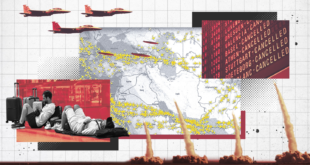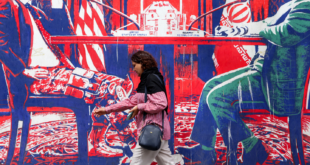Jordan is still in its boom phase with construction projects dotting the Amman skyline, but spaces are filling up, writes Nadine Marroushi.There is a buzz of activity all over Jordan as regeneration projects press ahead and property developers step in to attract investors to their ever-glitzier developments. In part, this trend can be directly linked to the Gulf region’s oil price windfall, which has spurred Arab investors from rich petro-states to spread their investments to poorer neighbours, like the basically well-managed but resource-poor Jordanian economy. From Casablanca to Amman, this is creating huge new urban developments that will change the face of many Arab cities forever.
In Jordan, other less positive factors are at play, too – notably the massive influx of Iraqis escaping their country’s civil conflict. Rating agency Standard & Poor’s says there are about one million Iraqis in Jordan. Not only does this include hundreds of thousands of poor refugees, who must be housed, but also wealthier Iraqis, who are investing heavily in their new homes.
According to an analyst from a leading global ratings company: “The amount of goods the Iraqi business elite are importing is now having a visible impact on the Jordanian balance of payments. The current account has turned from reporting a surplus to a deficit, due to the rise in Iraq-related imports, as well as the ending of subsidised oil imports from Saudi Arabia, Abu Dhabi and Kuwait.â€
High demand, high prices
High demand for housing, office space and leisure time in luxury resorts means prices are soaring. Observers say Amman is becoming overdeveloped, causing residents and developers to move into surrounding areas, such as Zarqa and Irbid.
Such is the amount of work now under way that market watchers in the region warn that supply for real estate may soon catch up with demand causing a shift in who has the upper hand, which currently lies with developers. According to local investment bank Amwal Invest: “Thus far, demand has outpaced supply causing property prices in Jordan to rise between 50% to triple the value. However, with the vast quantity of housing units and office buildings coming to the market over a short period of time, we envisage that within the coming two years a glut of properties could become available on the market, and the power will switch to the potential buyers’ side.â€
In this context, a price correction is expected.
A large part of the demand has been created from troubles in surrounding regions, mainly Iraq and Lebanon. Department of Land statistics show that in 2005 sale of land to non-Jordanians officially amounted to $208m, of which 67% came from Iraqis and 13% from Gulf Co-operation Council (GCC) states. By July, sale of land to non-Jordanians had already amounted to about $131m.
Jordanian nationals also want to buy. Jordan’s 5.6 million population has an estimated median age of 23, a large number of whom are looking for their first homes in an environment in which buying a property has become a more affordable option than renting. In 2001, the Landlord and Tenants Law was amended, abolishing provisions that allowed tenants indefinite residence at their original rent. Now, rent is variable and in most cases overpriced. Banks are offering attractive mortgage packages with interest at 8%-9%
Malls and financial centres
Jordan may have to exist in a tough neighbourhood, but with all this demand in a liberalising market, and with potential investors flush with oil-fuelled liquidity, it is hardly surprising that property developers have rushed to the scene. Mall and financial centre developments are the order of the day in the competitive state that is keen to match its Gulf neighbours.
The Jordan Securities Commission (JSC) is planning a single hub for financial businesses called the Jordan National Financial Centre. The $70m project involves moving the Amman Stock Exchange from its base in the Arjan district to the upmarket Shmeisani area, near the JSC building.
Kuwait’s Grand Real Estate Projects Company is developing a rival $250m Grand Amman Financial Complex in the Abdoun district, which is scheduled for completion in 2009. Built on a 20,000 square metre (m2) site, the complex will have twin towers, comprising a 42-storey five-star hotel with conference facilities, and a 40-storey office building. Also planned is a dome-shaped financial centre in the middle of the complex.
Malls are a relatively new concept to Jordan, but the idea has quickly gained traction. Two schemes are in the pipeline that will bring the total number of malls in Amman to eight. The $127m Tajamouat Group Abdoun Development is scheduled to open in 2008; it is being developed by the local Al Tajamouat for Tourist Projects company and will offer rental space of 60,000m2 in the first phase. Jordan-based Sky Real Estate Investment Company’s Al Baraka Investment & General Trade Company started building the 42,000m2 Al Baraka shopping mall in 2005 in the capital’s upmarket Swafieh district; it has just started operating.
Residential development
A number of real estate developments have followed the 2002 decision to relocate military facilities out of city centres, freeing up 2592 hectares of land, of which 80 hectares is located in Amman’s Abdali district, 12 hectares in Aqaba and 2500 hectares in Zarqa.
Zarqa, Jordan’s third most populated region, is home to the $1.3bn Madinat Al-Sharq residential project, providing housing for about 450,000 people. Developed by a public/private partnership of government-owned National Resources and Development Corporation (Mawared) and local developers, the project includes construction of 1200 residential units, including 100 semi-detached villas, 560 apartment buildings and 540 apartment complexes over a total built-up area of 196,597m2.
Mawared is also responsible for a $1.5bn mega-project in Amman known as the Abdali Urban Regeneration Project, which will develop mixed-use facilities over a total built-up area of more than one million square metres. Bordering the Palace of Justice, parliament building and King Abdullah Mosque, it will be the location of the American University of Jordan, high-rise towers, apartments buildings, retail outlets and recreation facilities.
Housing compounds
The newly established Andalucia Resorts and Real Estate Development Company is introducing Jordan to the housing compound concept, which is familiar to residents of the Gulf, through its $250m Andalucia Village project, an 800,000m2 mixed-use development located 15 minutes from Amman’s Seventh Circle, off the airport road towards Madaba.
Andalucia Resorts says 10 villa styles are being used in 620 two-storey villas, from 312m2 to 637m2; prices range from $367,279 to $690,738. Andalucia Resorts has signed a deal with Lebanon’s Bank Audi and Jordan Commercial Bank to offer interest-free financing packages. All the usual amenities are available in the village, including a shopping centre and recreational facilities.
Sky Real Estate is building an attached 30-storey residential and hotel tower in Amman’s Shmeisani area. According to Jalal al Gaaod, chief executive and partner at Sky Real Estate: “We will be offering clients who are interested in buying a residence, but are unable to utilise the residence all year long, the option to manage their property under the same hotel management group. This will allow clients to recover their investment, as well as utilising the property when in Jordan.â€
The residential tower will have two, three and four-bedroom residences, and four penthouses each with an area of 700m2.
Dead Sea and Aqaba
Major projects are under way to attract foreign and local investment to the Aqaba and Dead Sea areas. Developers are building resorts encouraged by the $800m Red Sea-Dead Sea project, which is building a canal, water conveyors and desalination plants.
The Grand Real Estate Projects Company is building a $100m health spa and resort along the Dead Sea coast, due for completion in 2008 on a total area of 150,000m2; it includes 680 rooms and 24 suites.
Dubai-based Omnix group is developing a Dead Sea resort called Crystal City. The $200m project, due for completion in 2008, involves the construction of three hotels, a water park, business centre, restaurants, retail outlets and related facilities spread over a total built-up area of about one million square metres.
One of Dubai’s property giants, Damac, has announced plans for a $150m mixed-use development on the Dead Sea, called Siwar.
Aqaba’s special economic zone, an area with tax concessions that has been developed to attract investment, is home to many mixed-use developments. One of the largest projects in the area is the $700m Ayla Oasis development by Ayla Oasis Development Company, a subsidiary of Saudi Arabia’s Arab Supply and Trading Company. It will be built on 4.3 square kilometres (km2) of land, and will involve the construction of five hotels, 3000 residences, a marina village, an artificial lagoon and an 18-hole golf course. The development is split into four phases and is due to be completed in 2014.
Lebanon’s Horizon Development has plans to construct a $5bn mixed-use real estate project in the area, covering a 22km2, and will feature a commercial district, recreational area, residential sector, high-rise office towers, logistics park and light industry zone.
The Jordan Projects for Tourism Development Company is building a $500m mixed-use development in Aqaba, called Tala Bay, where more than 1500 residences, five hotels, retail centres and recreational facilities are planned.
And Saraya Aqaba, headed by Saad Hariri, the son of former Lebanese premier Rafiq Hariri, is developing $600m-worth of mixed-use properties covering an area of 610,000m2
 Eurasia Press & News
Eurasia Press & News


